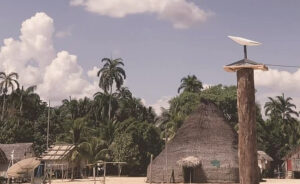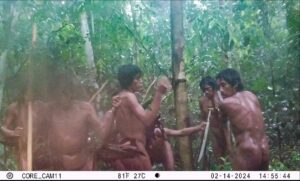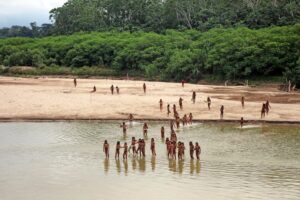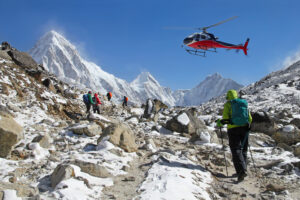Two years ago, Pete Casey put everything behind – he sold the house, replaced the trowel with a machete, the bricklayer’s shoes for comfortable walking shoes, and a suitcase for the backpack and left the concrete jungle to walk into the natural one.
He says about himself: “I do not have military, sports or scouting experiences, or the university education, and my life was quite typical for a Sussex builder.” Two years ago, he put everything behind – he sold the house, replaced the trowel with a machete, the bricklayer’s shoes for comfortable walking shoes, and a suitcase for the backpack and left the concrete jungle to walk into the natural one. Towalk in the literal meaning of the word! Pete Casey from Great Britain has set himself the goal of passing a considerable route – while traveling from the MOUTH to SOURCE of the AMAZON RIVER – he is planning to traverse South America from the Atlantic Ocean to the Pacific coast. In total about 5,000 miles. The very direction of his crusade – from the east to the west, not with the Amazon current, but against it, makes this trip unusual. The uniqueness of the expedition determines also the fact that Pete doesn’t use any means of transportation, apart from his own body. He just walks but when one of the numerous tributaries of the world’s largest river needs to be crossed, he swims across it. If it is necessary to get to the other bank of the Amazon itself, he also swims through it. Pete is accompanied by guides who are to provide some kind of security guarantee, especially in territories dominated by bandits engaged in smuggling, drug trafficking, and, above all, in robberies.
Pete has been traveling for last two years. During that time, he covered the distance of about 1,800 miles. He recently left the city of Tefe in Brazil. There is still a long way to go. “I am thinking of my further hike in terms of short goals: another larger town, crossing an important water basin,” says Pete. “I do not think and do not plan when I will reach the Amazon source, because this goal is still very far away in time and space.”
What prompted him to undertake such an expedition and sacrifice his current life for a few years of wandering through the Amazon? “I have always been fascinated by this extraordinary piece of our planet. I had an early experience with Amazon and from that first stay, I was thinking of returning to this part of the world to make the journey of my life. ”
While wandering, he carefully observes the surroundings, fascinated by
Amazonian flora and fauna, magnificent landscapes, jungle voices, colors and,
of course, he meets a lot of people – those friendly and cordial, but
sometimes, not only those ones. He shares his recent experiences on the
expedition in the interview given to Piotr Chmielinski.
Piotr Chmielinski (PCH) – Your journey through the Amazon has been going on for over two years; what were the most important lessons and experiences that you have you gained during this time?
Pete Casey (PC)
Patience
Well I guess if you subtract the 7 months I’ve had to spend in Manaus, on and off, my journey has been less than a year and a half. So I think learning to be patient may be the number one lesson. When I first started I was easily frustrated when things didn’t go according to the plan and took longer than expected, but now I sort of go with the flow (although of course I’m literally moving against it). I’ve realized that my journey has become more immersive and interesting as a result, and I keep reminding myself that I’m not in a race. What’s the point of trying to go as fast as I can with blinkers on, not taking in everything around me?
Advice
I’ve learned to listen carefully to local advice and take it seriously, but to use my intuition and read between the lines. The dangers clearly exist, but those which people talk about most are often exaggerated and out of proportion compared to reality. Unfounded fears can ruin a journey unnecessarily.
Happiness
I’m no anthropologist but it seems to me that happiness for humans is measured by more than just money or material possessions. I’ve witnessed people living simply – in a very real sense `hand to mouth` in some remote communities – and despite the lack of money and opportunity, they still seem to be content enough. In these communities, where everyone knows everyone else, people seem more trusting and trustworthy, more supportive of others, and more confident and happy. There is a real sense of belonging and identity, and I think in cities this has been lost. Our sense of self and self worth/respect and belonging, can be lost among the masses when we move from small communities into a city, where there is a danger of becoming just a number rather than a valued, unique and equal community member.
Guardians
I have also realized, after traversing the forest and seeing it first hand, that before the invention of motorized cutting tools and motorized vehicles, the forest was successful in protecting itself naturally with defenses that included the jaguar, the electric eel, mosquitoes, caiman, piranha, and a multitude of other animals and insects – the natural guardians of the rainforest. To these we can add a vast array of trees and plants with razor-sharp thorns, leaves, or bark that can shred your skin, or with spines the size of knitting needles, and of course the menacing dark swamps that nightmares are made of.
Feet
I’ve learned to look after my feet. I keep to a strict routine at night after setting up camp in the forest. Problems can develop rapidly if you don’t have the right footwear and don’t take your foot care seriously.
Plan
And finally a note about planning. I’ve learned to plan and prepare well, avoiding the temptation to move forward in haste. Once you’re in remote jungle, every step can be potentially dangerous, and timely rescue practically impossible.
I think this quote sums it up:
“Climb if you will, but remember that courage and strength are nought without prudence, and that a momentary negligence may destroy the happiness of a lifetime. Do nothing in haste; look well to each step; and from the beginning think what may be the end.”‘ [Edward Whymper, Scrambles Amongst the Alps]
PCH – Do you sometimes feel tired with this journey, do you dream of returning to a normal life, city, family, friends? What do you miss the most?
PC – I haven’t really felt mentally tired or bored, although I’ve definitely felt physically tired at times. There is a constant flow of new people, places, seasons, and things to learn.
Only on one occasion did the thought of returning home cross my mind. This was when I reached Oriximiná, Para. My original guide (and arguably my best so far) had to return home. I was suffering from malnutrition and was feeling incredibly weak, with a chronic chest infection. I thought a new guide I had found was plotting to murder and rob me, after other community members warned me about him, and the route ahead for the next few months looked daunting. To add to this, I received the very sad news from the UK that my mother had died. I felt helpless and almost overpowered by everything, and had to cling to the idea that my mother wouldn’t want me to stop until I had reached my goal. It was a dark place I had to journey through, but I came out of it eventually (and the guide was fine, in the end). Obviously I miss friends and family, but with the assistance of those wonderful orbiting satellites connecting the most remote parts of the planet, commutation with family and friends is a (relatively) practical proposition and is a fraction of the cost it was 20 years ago. I think without the communications technology I would feel more home sick, and I am continually amazed to find that some of the remotest communities have satellite Wi-Fi in their school.
In terms of what I miss about life back home, well let’s just say that I don’t really miss being self-employed, struggling to pay a mortgage and keep my head above water, and working outside in the winter months 6 or 7 days a week! Seriously, I do have rose-tinted memories of the cozy apartment I sold to raise the funds for the expedition – and I miss the psychological security of having a home to return to if it all goes pear-shaped or I run out of money (currently a very real prospect).
PCH – You have learned a lot about the Amazon – can you describe the River briefly: how do you perceive the Amazon, what surprised you about her, what she delighted you with, and what (if it was any) disappointed?
PC
Surprising
One of the things that surprised me was seeing the Amazon River at its highest level and then at its lowest, first hand. The sheer scale and force of the flowing mass of fresh water all year round is phenomenal. We should never take fresh water for granted. It is vital for all life on this planet, and transcends race, creed, culture and species. I was also surprised by the incredible generosity of the river people especially within the poorer communities I passed.
Delightful
Somewhere I had never heard of until I started planning the expedition – Marajó Island, the worlds largest fresh water island that sits at the mouth of the Amazon River, with its stunning, sandy, tidal beaches looking out across the Amazon and the Atlantic. In particular, the fishing community in Pesquero wasn’t what I had expected. I arrived there alone and feeling completely out of sorts, but the people – some of the poorest in Brazil – were more than keen to help me. I realized that unlike in the UK, where we are now dependent on money and imported food, I could probably live and survive on Marajó without money – much as the indigenous people have done for thousands of years. The forest and river always provide, if you know how to grow and harvest the vast amount of fruit and vegetables and know how to catch the many types of freshwater and saltwater fish, crabs, prawns.
Disappointing
I wouldn’t say I’ve been disappointed. The only thing that I can think of without getting into the current political situation is that people still kill and eat animals that are endangered even though they are aware of the issue. And of course the ongoing deforestation is incredibly disappointing, as is the amount of plastic and rubbish I’ve seen floating in the rivers especially around Manaus. I want to get on a soapbox somewhere and remind people that without the forest there will be no rain, without rain no rivers, without rivers no water and no food. Without water the land will become a desert. “Water is the driving force of all nature”.
| PCH – What are the biggest threats you encountered on the Amazon?
What were your most dangerous experiences on the Amazon? |
PC
Threats
To date I would say the biggest threats so far have been mainly health issues. Dehydration, severe stomach upsets on 5 occasions – probably after swimming in polluted rivers near cities, or drinking unclean water – then the obvious risk of contracting malaria, and the need to take preventive Doxycycline every other day. There are the wild animals, too, of course. I once swam across a 3-kilometre lake – and as I swam, several Caiman exited the lake onto the shore either side. I can’t always know what’s lurking beneath! I’ve also been very lucky and had a few near misses with venomous scorpions and snakes. Contact with people can also be an issue. Walking along the road BR319 on my own for 5 days was scary after I was told I would probably be robbed, shot at and eaten by Jaguars. On one occasion I passed a group of about 10 young guys sitting by the side of the dusty red, deserted road. I thought they were carrying shotguns, and as I passed , they stood up and started walking about 25 meters behind me. I thought my time was up, and they were still there about an hour and a half later, when I walked into the only community I had seen in days. It turned out that the guys following me belonged to the evangelical community that I had entered and were walking home after hunting I think.
I had a lucky escape in Manaus, near the port, when four young guys tried to rob me and take my backpack. I managed to push them back and run as fast as I could. Luckily, some of the market workers blocked their path and I got away. In spite of this, I have to add that the city is probably as safe as Central London – you just have to be aware (I was filming in the fish market on my own at the time).
Most dangerous?
I guess the actual traversing of jungle and rivers during flood season can be incredibly dangerous – the previous blog post give some insight into the dangers (https://www.ascentoftheamazon.com/2017/02/light-end-jungle/).
PCH – How do the natives react getting known about the purpose of your trip and the way it is carried out?
PC – Most of the time they are very surprised, especially when we exit the forest at the back of people’s houses, usually on the bank of a river. Everyone travels by boats here so we have to explain a few times before they understand. Then they would still keep telling us to use a boat to move forward “because it’s not possible to walk”! (Many of the people here have a fear of entering deep into the jungle, which is why it’s difficult to find anyone willing to walk with me). Now, many of the remotest communities have a satellite dish and a television and they see adventure documentaries on television, so they understand that people have adventures. Most of the time we are treated like special guests, and are nearly always invited to wash, eat and sleep in the first house we encounter, despite the community’s relative poverty. The hospitality has been overwhelming. I’m not sure it will be quite the same once I enter Peru, but I hope so.
PCH – Is there any place, event or experience (including the aesthetic one, for example, the admired landscape, the view), you will particularly remember from this part of the trip? Please, describe them in a few sentences.
PC – Memorable, yes – almost too many to mention, but there a few that stand out:
When I walked to the start point of my journey at dusk after making camp on the most easterly coastal point of Marajó island, it was overwhelming. The view of the mouth of the mighty Amazon meeting the vast Atlantic Ocean with the sun setting and the deserted, golden-sand coast peppered with weathered tree stumps… (see second photo) I had finally arrived at a point that I had been looking at on Google Earth and dreaming about over the years of planning prior to starting my journey.
I contemplated the immense journey that lay ahead and also thought about all the ships and people that had passed here over the last 500 years – from the first wooden ships of Yáñez Pinzón (https://biography.yourdictionary.com/vicente-yanez-pinzon), to today’s gigantic cargo, oil and mineral containers, changing the face of the Amazon rainforest and all of South America forever.
More recently, I would say on the last but one day on the Coari to Tefe leg, we had to leave the comfort of our hammocks very early to cross the last river/Lago Caiambe. We were in a tiny community where we had passed the night. The colorful wooden houses sat high up overlooking the river, a slight chill was in the air, and the skies were dark & moody after the previous night’s heavy rain. The lower-lying rainforest we were about to cross on the other side of the river was bathed in a blanket of mist covering all but the canopy, and we were all in good spirits as we knew we would make it safely in time for Christmas. The dawn chorus of insects and birds erupted, and one of the indigenous women was singing a beautiful traditional song in her house in front of the river. On her veranda was a solitary artificial Christmas tree. Just before we left, the local teacher brought us freshly baked and still warm bread and coffee and we said our goodbyes.
It’s one of many unforgettable moments. It’s so hard to capture with a camera, but perhaps you can get some idea from the panoramic photo I took that morning.
PCH – What are your plans for the coming months?
PC – The seasonal frequent heavy rains have
started, and rivers are already rising at a frightening pace. I need to get
across the Rio Juruá before the annual floods reach full height. It is one of
the last big tributaries before I get across the border into Peru, and out of
the whole expedition this is the one section I have been most concerned about,
especially now that I have lost several weeks of low water time waiting for
guides. The Juruá river floods a long way into the forest either side up to 10 meters
deep or more in places. (See NASA satellite image). Apprehension will be
the prominent emotion as I start this next leg. I hope to get to Amaturá and
higher ground before April, depending on guides, timing and all things going to
plan.
For previous story check this link: https://explorersweb.com/Natal-Christmas-in-Tefe-Amazonas-for-Pete-Casey-2017-12-24-44218
Additionally, check this text in National Geographic – Polska: https://www.national-geographic.pl/national-geographic/ludzie/od-konca-amazonki-do-poczatku-na-piechote-i-wplaw-wywiad-z-podroznikiem






